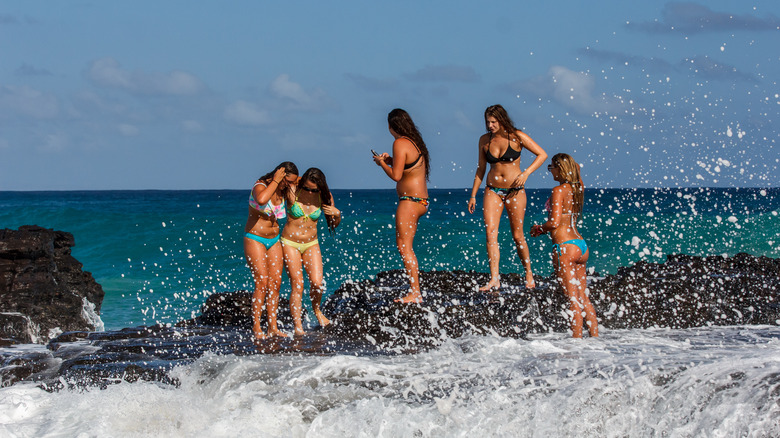The Unsettling Reason Beaches In Hawaii Are Considered The World's Most Dangerous
Many people dream of a vacation in Hawaii. They may envision spending their days under a gently swaying palm tree while they sip a Mai Tai and watch the ocean or checking out some of Hawaii's best snorkeling spots. But as enticing as this dream may be, it's important to realize that thanks to the state's geography, Hawaii has some of the world's most dangerous beaches.
Due to Hawaii's location in the middle of the Pacific Ocean, the waves that crash onto the shore carry energy generated across a much larger area than waves along the coasts of the continental U.S. There's no continental shelf to slow down the waves as they head toward Hawaii. Hence, they break with much greater force than on the mainland. A wave breaking on the shore you can handle without falling over in California or Florida could knock you down easily in Hawaii.
This can lead to more than just embarrassment. Serious spinal cord injuries have resulted in Hawaii from waves just three feet high. While the waves at every Hawaiian beach can pack a punch, Oahu's Sandy Beach and Maui's Makena Beach are known for intense shore breaks that have unfortunately led to several emergencies over the years.
Hawaii's north shores can be particularly dangerous during winter
Hawaii's geography also means that winter storms from far away have an impact on beach safety. In general, the waves on the south shores of the islands are stronger in the summer, and some of Hawaii's biggest, strongest waves hit the north shores in the winter. Storms that form in the North Pacific Ocean push energy towards Hawaii, and the swells can build into waves the size of multi-story buildings by the time they get to Hawaii's north shores.
Those big waves can make north shore beaches in the winter into hazardous places if you don't know what you're doing. Popular spots like Shark's Cove along Oahu's famed north shore might seem idyllic, but big winter waves can catch you unawares. A general rule of thumb — if you're standing in a wet spot, water has reached that far recently, even if the shoreline doesn't look that close. You could be in trouble when the next big wave set comes in.
Respect the ocean and never turn your back to it
While Hawaii's big waves may have a seasonal pattern, it's not a hard and fast rule. Wave heights and strength can change quickly, regardless of the beach. Plus, unexpectedly large waves can hit seemingly out of nowhere, no matter the season. These aptly named sneaker or rogue waves can knock you down and pull you into the ocean, even if you're higher on the beach. Such situations have led to one of Hawaii's most crucial guidelines for beach safety: "It's not a good idea to turn your back on the ocean," Chief of Ocean Safety John Titchen told KHON2. "Keeping track of the breaking surf, the sets, the current, the changing conditions are all valuable skillsets, and this is hard to do when you turn your back to the ocean."
Even if the water doesn't look dangerous, don't just charge into it without knowing what you're getting into; there may be strong currents and hazards that you can't see. When in doubt, check in with a lifeguard at the beach. Listen to lifeguards if they tell you to stay out of the water and remain on land if you see red flags on the beach. Drowning was the leading cause of death for tourists in Hawaii between 2009-2018, according to the Hawaii Department of Health. Don't become a statistic or endanger lifeguards by forcing them to rescue you.


